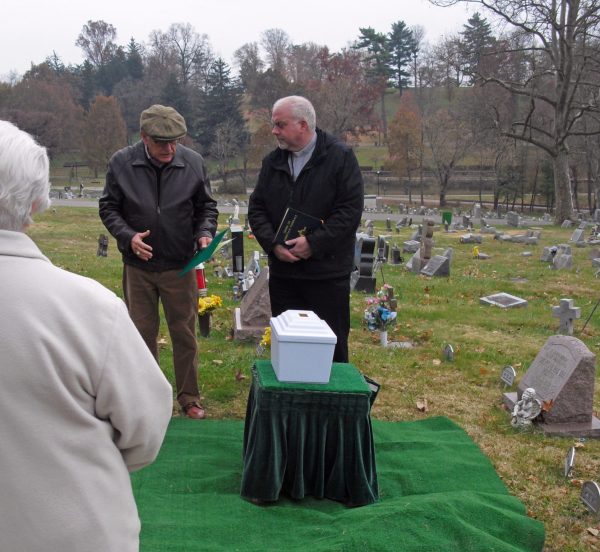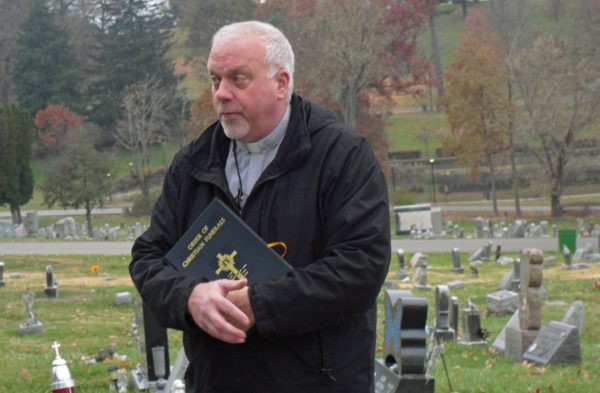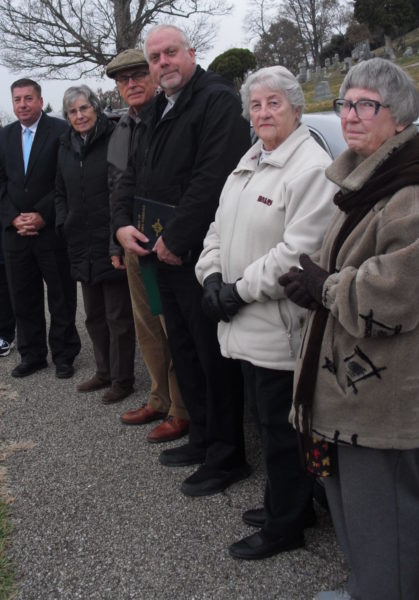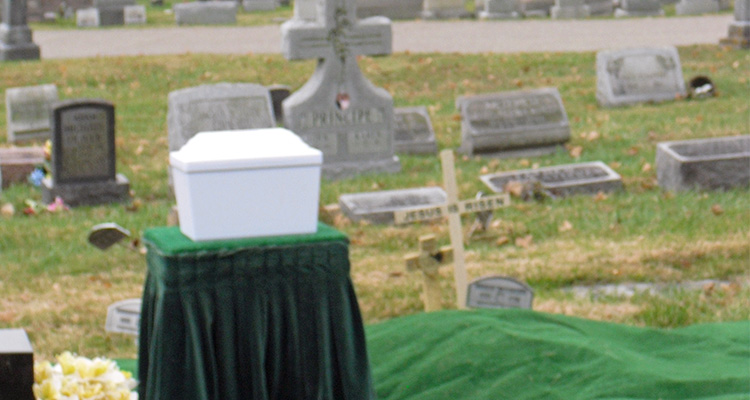Editor’s note: In late October, Weelunk posted a story by Kelly Strautmann that gave an in-depth look at how this community-sponsored burial came to be. Click here for the back story.
No one knows her name, but a teenage girl who may have been born when the Civil War was barely over was buried in the city on Tuesday.In a small ceremony, the combined cremains of the unknown youth and a partial set of skeletal bones from at least one adult were buried at Mount Calvary Cemetery. For decades, possibly even as far back as 1892, the bones helped nurses training at the former Ohio Valley Medical Center and its predecessors.
“Who knows what it is that these bones were able to do?” asked Jim Stultz during the brief graveside service.
“Who knows what it is that these bones were able to do?” — Jim Stultz
Stultz, a retired OVMC executive, was among a handful of area residents responsible for retrieving the bones from the recently shuttered hospital and arranging for their cremation and burial.

He estimated at least hundreds of nurses — some of them still living in the city and its surrounds — used them while in training. Stultz, in fact, ran into a 1953 graduate of the former nursing school in recent days.
“I remember sitting at a table, and we had some (bones) that we were looking at and trying to memorize for a test,” the Moundsville woman told Stultz.
How the bones helped such nurses to help others, here and elsewhere, deserves to be honored and remembered, Stultz continued in his graveside comments.
“Being humans, we understand the (meaning) of life. Being persons of God, we understand that we are all children of God,” he said.
Noting that becoming a medical skeleton so long ago suggests poverty or orphanhood, he continued. “Life might have been difficult. Life may have been painful. … We also know that they were loved by God.”
In the same theme, during a Christian commitment service, Doug Breiding referred to the valued work of, “our sister and the other remains.”

A SIGN OF HEALING
Prior to the service, both Stultz and Margaret Brennan, a local historian who was also among those instrumental in the burial, said it was impossible to overlook the connection between the memorial and community grief over the loss of OVMC.
“I do think there is symbolism there,” Brennan said of Catholics and Protestants, OVMC representatives and Wheeling Hospital representatives coming together to both remember and celebrate the bones’ unusual work. “(It’s) the idea of supporting one another in a community.”
As pieces fell into place to allow the burial, Brennan said, “I thought, ‘Wow, how good people are in the valley.’”

Stultz agreed, saying it’s also good to be able to have some closure and begin looking ahead.
“It’s very hard to have any sense of a good feeling,” he said of going into the closed OVMC to actually get the bones. “You have memories of the good work that was done there, but [the building’s] just so empty … [As with the bones], there’s not a happy ending, but, we hope, a dignified ending.”
• A long-time journalist, Nora Edinger also blogs at noraedinger.com and Facebook and writes books. Her Christian chick lit and faith-related non-fiction are available on Amazon. She lives in Wheeling, where she is part of a three-generation, two-species household.


